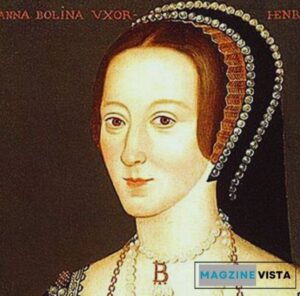Anne Boleyn was the mother of Queen Elizabeth I and the second wife of King Henry VIII of England. Henry broke with the Roman Catholic Church and started the English Reformation due to the circumstances surrounding the annulment of his marriages to Catherine of Aragon, his first wife, and Anne.
Who is Anne Boleyn?
With the Roman Church refusing to grant him an annulment from his first wife and the fact that his mistress was Anne’s sister Mary, King Henry VIII’s second marriage to Anne Boleyn was scandalous. Therefore, to wed King Henry and Ann Boleyn VIII defied the Church.
Although unable to produce a son, she gave birth to a daughter. Boleyn was hanged on May 19, 1536, due to fabricated accusations of incest, adultery, witchcraft, and plotting against the monarchy. One of England’s most notable queens was her daughter Elizabeth. May 19, 1536, was Boleyn’s date of death in London.
Facts About Anne Boleyn

| Name | Anne Boleyn |
| Anne Boleyn Date Of Birth | around 1501, in Norfolk |
| Died | 19 May 1536, at Tower Green (executed) |
| Reigned | 1533–36 |
| Coronation | 1 June 1533 |
| Parents | Sir Thomas Boleyn and Elizabeth Howard |
| Children | Elizabeth I |
| Spouse | Henry VIII |
| Succeeded by | Jane Seymour, Henry VIII’s third wife |
Early Life
Anne Boleyn was born about 1501 and was the daughter of Sir Thomas Boleyn and Lady Elizabeth Howard, the future lord of Wiltshire and Ormonde. Boleyn, who had spent some time as a young woman in France, came to England in 1522 and quickly made herself at home at King Henry VIII’s court, serving as Catherine of Aragon’s maid of honor. At the time, Henry VIII was the queen consort.
He wrote to Anne Boylen.”If you… give yourself up, heart, body, and soul to me, All others, but for yourself, shall be rejected from my thoughts and heart in favor of serving you alone as my mistress.“However, Boleyn responded negatively, stating that her goal was to get married rather than have a mistress: “I cannot be your wife because of my unworthiness and because you already have a queen.” I will not be your mistress.”
Queen of England

After six years of argument, during which king Henry and Anne Boleyn had covertly courted, Anne Boylen discovered she was expecting in the first quarter of 1533. Henry and Anne Boleyn swiftly wed on January 25, 1533, in a covert ceremony officiated by Canterbury Archbishop Thomas Cranmer, without the pope’s approval.
A sumptuous coronation ceremony was staged in June of the following year to commemorate the new queen. Elizabeth I, Queen Anne’s sole child by Henry viii and Ann boleyn to survive infancy, was born on September 7, 1533. (Anne would become twice more pregnant in 1534 and 1536 and have a stillborn child each time.) Because Catherine Aragon was the king’s sister-in-law, Archbishop Cranmer declared Henry’s marriage to her void in 1534. Henry then established the Church of England, severing England from Rome. In 1536, two years later, Catherine would die.
Execution and Legacy
Henry VIII determined it was time to assume responsibility for Boleyn’s legacy following her stillbirth in January 1536. He soon decided to wed Seymour and applied to have his marriage to Boleyn annulled. He subsequently ordered Boleyn’s imprisonment at the Tower of London on several unfounded accusations, including incest, adultery, and conspiracy. Boleyn’s erstwhile friend and Chief Minister Thomas Cromwell is thought to have planned her downfall.
The trial of Boleyn began on May 15, 1536. Anne Boelyn maintained her composure and ability to speak in court, vehemently refuting every accusation made against her. Henry’s marriage to Boleyn was deemed null and void after a court of peers unanimously found her guilty four days later, on May 19, 1536. On that very day, a French swordsman brought Boleyn to London, England’s Tower Green, for her death.
Anne Marries Henry VIII
Seven years after their courting started, Ann Bolyn eventually wed Henry in January of 1533. Henry’s marriage to Anne was officially bigamous since his union with Katherine was not dissolved until May 1533.
Anne was brought to the Tower of London by water in May 1533, where she got ready for her coronation in the royal chambers and then rode in a triumphant parade to Westminster. Six months pregnant, on June 1, Anne was crowned Queen in Westminster Abbey. Elizabeth I was the healthy daughter of Henry and Anne, who had their first child on September 7, 1533.
Henry separated from the Roman Catholic Church the next year and installed himself as the Supreme Head of the future Church of England. For the next 200 years, Britain experienced political and theological turmoil due to the shockwaves this unleashed.
She and Jane Seymour had a falling out.
In the first several months of 1536, Anne Boleyn was uncomfortable with the increasing friendship that Henry was having with her maid, Jane Seymour. Henry gave Jane his photo, which she wore around her neck, just as he had done early in their relationship with Anne Bolin.
Upon witnessing this, the queen grabbed it from her opponent with such force that her hand was injured. Jane Dormer, who subsequently worked for Princess Mary, also reported that she and Anne frequently scuffled and struck each other.
Anne Boleyn Arrest And Trail
Cromwell took decisive action against Anne in 1536. The Queen, her brother, and a small handful of courtiers were accused of infidelity and even of planning to assassinate the King.
Arrested on May 2, 1536, Anne was transported to the Tower of London by barge, where she arrived at the private postern gate (today known as the Byward Tower).
The Queen’s claims of innocence were disregarded by Henry VIII, who was known for being suspicious and was currently enamored with Jane Seymour, one of Anne’s ladies-in-waiting.
After being found guilty in a fake trial that included many of Anne’s adversaries, she was imprisoned in the Tower of London, in the royal chamber where she had been waiting for her coronation for only three years.
Anne nearly died of the sweating sickness.
The sweating illness, possibly an influenza variant, was a common ailment in Tudor, England, that was characterized by its ability to swiftly take the life of an otherwise healthy and young victim. The French ambassador, Cardinal du Bellay, said, “It is the easiest in the world to die of.“
Fearful of the illness, Henry VIII retreated 12 miles away when one of Anne’s women passed away from perspiration in June 1528. He then gave Anne the order to return home to Kent. Despite being unchivalrous, Henry’s precautions made sense when Anne was diseased.
Also Read: Meet Ash Kash | Career, Bio, Net Worth
Conclusion
Even after all these years, many questions surround Queen Anne Boleyn’s life. There is much to be discovered because of the scant proof of her survival and her brief rule. Many of her belongings were taken away after her execution, including images of the monarch. But Anne Boylen became a pivotal figure in the annals of Tudor theology.
FAQs
Why is Anne Boleyn so famous?
Anne Boleyn is well-known and one of the most fascinating people in British history.
How many pregnancies did Anne Boleyn have?
Throughout her life, Anne Boleyn is known to have been pregnant four times.
What caused Henry to lose interest in Anne?
Anne’s ugly physical attributes result from his inability to ‘perform his role.’
How did Anne Boleyn survive the sweating sickness?
She was able to survive.



